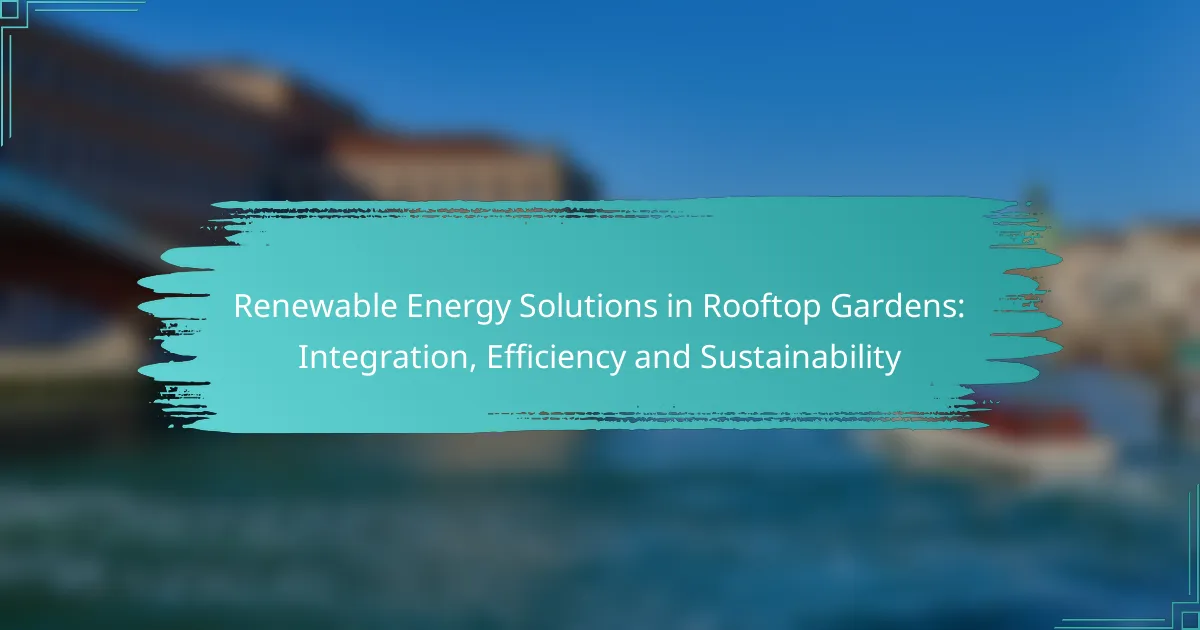Rooftop gardens represent a unique opportunity to integrate renewable energy solutions, enhancing urban sustainability through improved energy efficiency and biodiversity. By strategically incorporating solar panels alongside greenery, these gardens not only optimize energy production but also contribute to better stormwater management and increased property values. Regular maintenance and smart plant selection further ensure that these green spaces remain efficient and environmentally friendly.
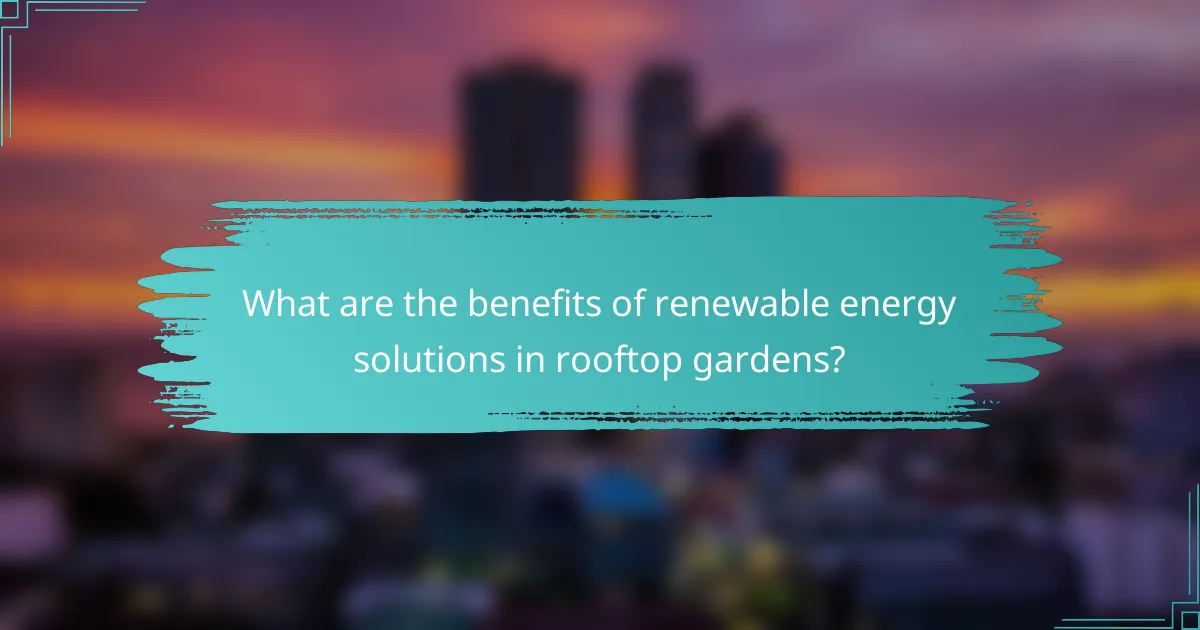
What are the benefits of renewable energy solutions in rooftop gardens?
Renewable energy solutions in rooftop gardens offer numerous advantages, including enhanced energy efficiency, improved biodiversity, and better stormwater management. These benefits contribute to a more sustainable urban environment while increasing property value.
Energy efficiency improvements
Integrating renewable energy solutions, such as solar panels, into rooftop gardens can significantly enhance energy efficiency. By generating electricity on-site, buildings can reduce their reliance on grid power, leading to lower utility bills and decreased carbon footprints.
To maximize energy efficiency, consider installing energy-efficient appliances and using smart technology to monitor and manage energy consumption. This combination can lead to energy savings of 20-30% in urban settings.
Enhanced urban biodiversity
Rooftop gardens can serve as vital habitats for various plant and animal species, thereby enhancing urban biodiversity. By incorporating native plants and creating diverse ecosystems, these gardens support pollinators and other wildlife.
To promote biodiversity, select a variety of plants that bloom at different times throughout the year, ensuring a continuous food source for local fauna. This approach not only benefits wildlife but also contributes to the overall health of the urban ecosystem.
Reduction in urban heat island effect
Rooftop gardens help mitigate the urban heat island effect by providing natural insulation and reducing surface temperatures. Vegetation absorbs sunlight and cools the air through evapotranspiration, leading to cooler urban environments.
Implementing green roofs can lower surrounding temperatures by several degrees, which can be particularly beneficial in densely populated areas. This cooling effect can reduce the need for air conditioning, further lowering energy consumption.
Stormwater management
Rooftop gardens play a crucial role in stormwater management by absorbing rainwater and reducing runoff. This helps prevent flooding and minimizes the burden on urban drainage systems during heavy rainfall.
To optimize stormwater management, design gardens with a variety of soil types and plant species that can retain water effectively. This strategy can reduce runoff by up to 50%, making urban areas more resilient to extreme weather events.
Increased property value
Incorporating renewable energy solutions in rooftop gardens can lead to increased property value. Properties with green roofs are often more attractive to buyers due to their sustainability features and lower operating costs.
Research indicates that homes with green roofs can see a property value increase of 5-15%. Investing in renewable energy solutions not only benefits the environment but also enhances the long-term financial prospects of property owners.
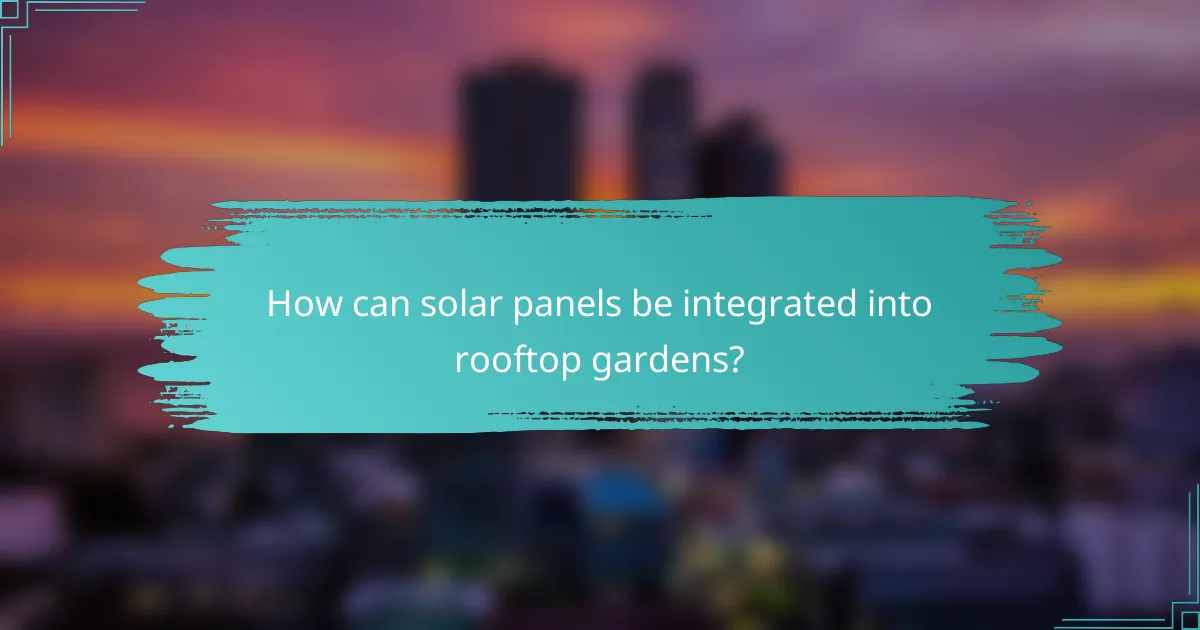
How can solar panels be integrated into rooftop gardens?
Integrating solar panels into rooftop gardens involves strategically placing solar technology alongside or above vegetation to optimize energy production while maintaining green space. This combination enhances sustainability, reduces energy costs, and promotes biodiversity in urban environments.
Installation methods for solar panels
There are several installation methods for solar panels in rooftop gardens, including flush mounting, ballasted systems, and rack-mounted options. Flush mounting involves attaching panels directly to the roof surface, while ballasted systems use weights to secure panels without penetrating the roof. Rack-mounted systems elevate panels above the garden, allowing for better airflow and sunlight access.
When choosing an installation method, consider factors such as roof type, structural integrity, and local building codes. It’s essential to consult with professionals to ensure compliance with regulations and optimal performance.
Optimal positioning for sunlight exposure
To maximize energy production, solar panels should be positioned to capture the most sunlight throughout the day. Ideally, panels should face south in the Northern Hemisphere and north in the Southern Hemisphere, with a tilt angle of around 30-45 degrees. This positioning allows for optimal exposure during peak sunlight hours.
Regularly assess shading from nearby structures or trees, as even partial shading can significantly reduce panel efficiency. Adjustments may be necessary to ensure that panels receive unobstructed sunlight for the majority of the day.
Combining solar panels with green roofs
Combining solar panels with green roofs creates a synergistic relationship where both systems benefit from each other. The vegetation helps cool the panels, improving their efficiency, while the panels provide shade that can reduce water evaporation from the plants. This integration promotes a healthier ecosystem and enhances energy efficiency.
When implementing this combination, ensure that the structural design accommodates the weight of both the green roof and the solar panels. Additionally, consider using lightweight soil and drought-resistant plants to minimize maintenance and maximize sustainability.

What are the best practices for maintaining energy efficiency?
Maintaining energy efficiency in rooftop gardens involves regular monitoring and strategic choices that enhance sustainability. Key practices include conducting system inspections, utilizing energy management systems, and selecting energy-efficient plants.
Regular system inspections
Conducting regular inspections of energy systems is crucial for identifying inefficiencies and ensuring optimal performance. Schedule inspections at least twice a year to check for wear and tear, leaks, or any malfunctioning components.
During inspections, focus on solar panels, irrigation systems, and any integrated energy solutions. Addressing issues promptly can prevent larger problems and maintain energy efficiency.
Utilizing energy management systems
Implementing energy management systems (EMS) can significantly enhance energy efficiency in rooftop gardens. These systems monitor energy consumption in real-time, allowing for adjustments that optimize usage and reduce waste.
Consider systems that provide analytics and reporting features, which help in understanding energy patterns and making informed decisions. Look for EMS that integrate with existing technologies to streamline operations and improve overall efficiency.
Choosing energy-efficient plants
Selecting energy-efficient plants is essential for maximizing the sustainability of rooftop gardens. Opt for native or drought-resistant species that require less water and maintenance, thereby reducing energy use in irrigation.
Additionally, consider plants that provide natural insulation or shade, which can lower energy demands for heating and cooling in surrounding buildings. Research local climate conditions to choose the most suitable varieties for your rooftop garden.

What are the costs associated with implementing these solutions?
The costs of implementing renewable energy solutions in rooftop gardens can vary widely based on factors such as system size, technology, and location. Key expenses include initial investments for solar installations, ongoing maintenance, and potential long-term savings on energy bills.
Initial investment for solar installations
The initial investment for solar installations typically ranges from several thousand to tens of thousands of dollars, depending on the size and complexity of the system. Factors influencing this cost include the type of solar panels, inverter systems, and installation labor. In many regions, government incentives or rebates can significantly reduce upfront expenses.
For example, in the United States, the federal solar tax credit allows homeowners to deduct a substantial percentage of the installation costs from their federal taxes, making solar more accessible. It’s essential to obtain multiple quotes from certified installers to ensure competitive pricing.
Long-term savings on energy bills
Long-term savings on energy bills can be substantial, often amounting to hundreds or even thousands of dollars over the lifespan of the solar system. Homeowners may see a reduction of 50% or more in their electricity costs, depending on their energy consumption and local utility rates.
Additionally, some regions offer net metering programs, allowing homeowners to sell excess energy back to the grid, further enhancing savings. It’s advisable to analyze your energy usage and local rates to estimate potential savings accurately.
Maintenance costs over time
Maintenance costs for solar installations are generally low, averaging around 1-2% of the initial investment annually. Regular maintenance typically includes cleaning solar panels and checking system performance to ensure optimal efficiency.
While solar panels are designed to last 25 years or more with minimal upkeep, unexpected repairs can arise. It’s wise to budget for potential repairs and consider warranties that cover equipment failures or performance issues over time.
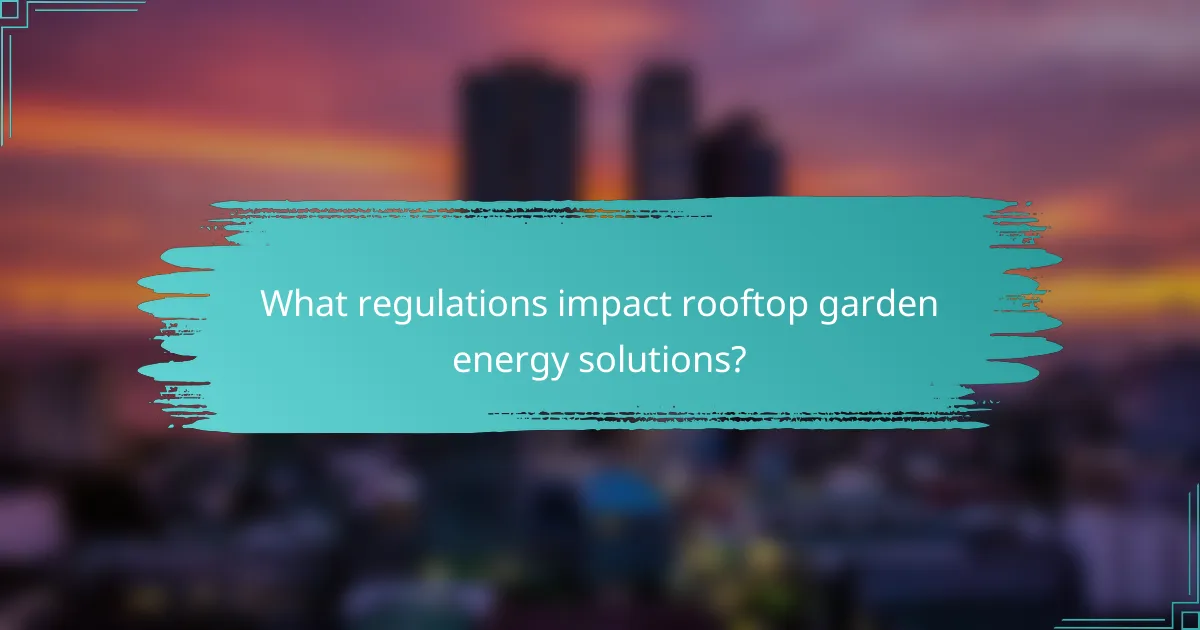
What regulations impact rooftop garden energy solutions?
Rooftop garden energy solutions are influenced by various regulations that govern land use, construction, and energy efficiency. Understanding these regulations is crucial for successful integration of renewable energy systems in urban environments.
Local zoning laws
Local zoning laws dictate how land can be used and can significantly impact rooftop garden projects. These regulations may specify the types of structures allowed, height restrictions, and the percentage of land that can be covered by gardens or energy systems. Before starting a project, check with local authorities to ensure compliance with zoning requirements.
In many cities, zoning laws may also include provisions for green spaces, which can encourage the development of rooftop gardens. Familiarizing yourself with these laws can help in obtaining necessary approvals and avoiding potential fines.
Building codes and permits
Building codes establish the safety and structural integrity standards for rooftop gardens and energy installations. These codes often require permits that ensure compliance with safety regulations, such as load-bearing capacities and fire safety measures. It’s essential to consult with a licensed architect or engineer to navigate these requirements effectively.
Permits may vary by location, so be prepared for different processes depending on your city or state. Engaging with local building departments early in the planning process can streamline approvals and help avoid delays.
Incentives for renewable energy adoption
Many regions offer incentives to promote renewable energy adoption, which can significantly offset the costs of integrating energy solutions in rooftop gardens. These incentives may include tax credits, rebates, or grants for installing solar panels or other renewable technologies.
Research available programs in your area, as they can vary widely. For example, some states in the U.S. provide substantial financial incentives, while others may have limited options. Utilizing these incentives can enhance the financial viability of your rooftop garden project.
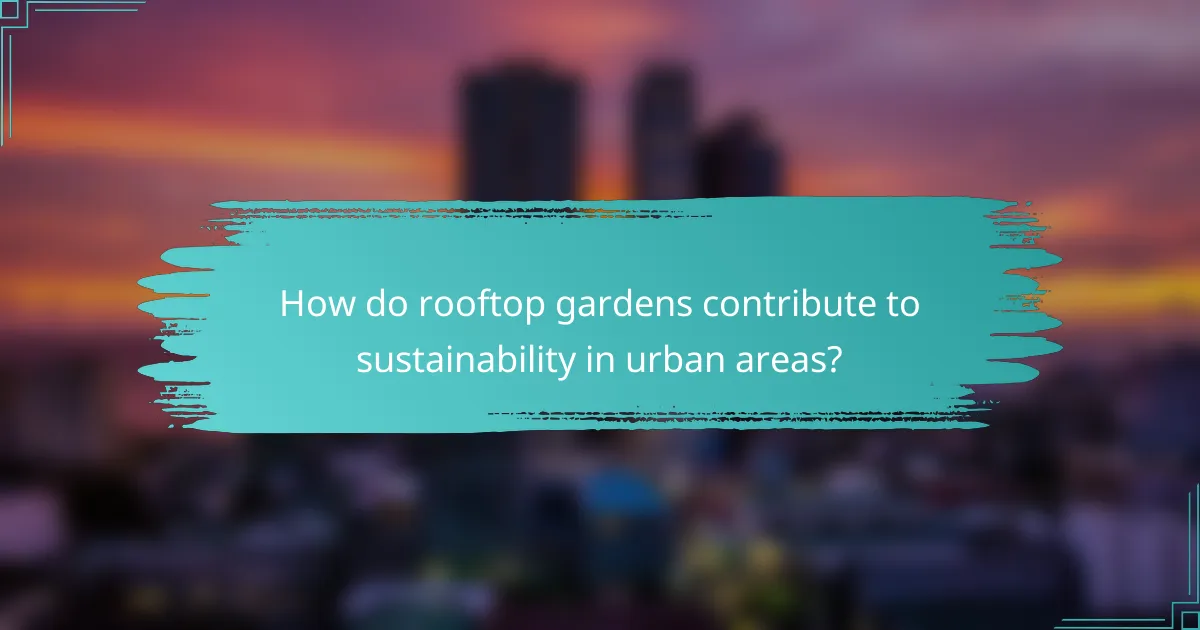
How do rooftop gardens contribute to sustainability in urban areas?
Rooftop gardens enhance sustainability in urban environments by improving air quality, reducing heat, and promoting biodiversity. These green spaces help mitigate urban heat islands, manage stormwater, and provide habitats for various species.
Integration of Renewable Energy Solutions
Integrating renewable energy solutions with rooftop gardens can significantly enhance their sustainability impact. Solar panels can be installed alongside green roofs, allowing for energy generation while providing insulation and reducing energy costs. This combination can lead to lower electricity bills and a reduced carbon footprint.
Consider using solar energy systems that are compatible with the structural integrity of the rooftop garden. Ensure that the installation does not compromise the garden’s soil and plant health. Regular maintenance of both the garden and the solar panels is essential for optimal performance.
Efficiency of Rooftop Gardens
The efficiency of rooftop gardens in urban areas can be measured by their ability to retain rainwater and provide insulation. These gardens can absorb significant amounts of rainfall, reducing runoff and lowering the risk of flooding. Additionally, they can lower indoor temperatures, which decreases the need for air conditioning.
To maximize efficiency, select drought-resistant plants that require less water and are well-suited to the local climate. Implementing a drip irrigation system can also help conserve water while ensuring the plants thrive. Regularly assessing plant health and soil quality will maintain the garden’s effectiveness.
Sustainability Practices for Rooftop Gardens
Implementing sustainable practices in rooftop gardens involves using native plants, organic gardening methods, and efficient water management. Native plants are adapted to local conditions and require less maintenance, making them ideal for urban settings.
Utilize compost and organic fertilizers to enrich the soil without harming the environment. Rainwater harvesting systems can be installed to collect and reuse water for irrigation, further promoting sustainability. Regularly monitor the garden for pests and diseases, opting for natural remedies to minimize chemical use.
